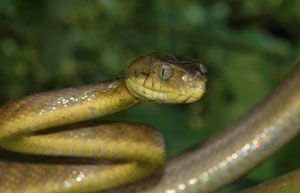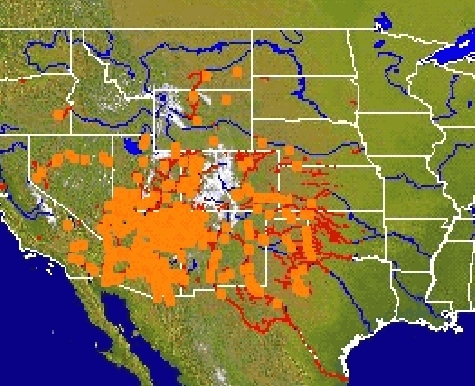| |
WELCOME
to the USGS Invasive Species Program
America is under siege by many harmful non-native species of plants, animals, and microorganisms. More than 6,500 nonindigenous species are now established in the United States, posing risks to native species, valued ecosystems, and human and wildlife health. These invaders extract a huge cost. The current annual environmental, economic, and health-related costs of invasive species exceed those of all other natural disasters combined.
USGS plays an important role in Federal efforts to combat invasive species in natural and semi-natural areas through early detection and assessment of newly established invaders, monitoring of invading populations; improving understanding of the ecology of invaders and factors in the resistance of habitats to invasion; and development and testing of prevention, management, and control methods. USGS invasive species research encompasses all significant groups of invasive organisms in terrestrial and aquatic ecosystems in all regions of the United States. Working collaboratively with partner agencies and organizations, USGS provides the tools, technology, and information supporting efforts to prevent, contain, control, and manage invasive species nationwide.
The USGS Invasive Species Program provides methodologies and information to address threats to ecological systems and native species due to the introduction and spread of invasive species. The program's Five-Year Strategic Plan outlines goals, strategies, and requirements for significantly increasing efforts on the part of USGS during fiscal years 2005 - 2009, helping the Department of the Interior managers and the Nation respond more rapidly and effectively to the growing threat of invasive species in U.S. ecosystems.
Research components of the Invasive Species Program include:
For a list of the most current Invasives program research projects, visit the Invasive program's Highlighted Projects page. |
|
 |
|
|
| |
Research Highlight

Brown Treesnake (Boiga irregularis): Fact Sheet for Pacific Island Residents and Travelers (.pdf)
The brown treesnake is an introduced species on Guam that has become a serious pest. The snakes probably arrived on Guam hidden in ship cargo from the New Guinea area, about 1100 miles to the south. The first sightings were inland from the seaport in the early 1950s. Snakes became conspicuous throughout central Guam by the 1960s, and by 1968, they had probably dispersed throughout the island. In the absence of natural population controls and with vulnerable prey on Guam, the snakes have now become an exceptionally common pest, causing major ecological and economic damage on the island. Get more information by downloading the fact sheet.
|
|
| |
|
 |
|
In the Spotlight
 Stalking Snakes: Days (and Nights) in the Life of a Brown Treesnake Rapid Responder (By James Stanford, USGS Rapid Response Team Coordinator, Guam) - From the website: "To understand what is involved in defending snake-free islands against this unwanted, highly adaptable invader, you are invited to take an 18-month journey through a chronicle of “life as a USGS Rapid Response Team coordinator”..." Read More >> Stalking Snakes: Days (and Nights) in the Life of a Brown Treesnake Rapid Responder (By James Stanford, USGS Rapid Response Team Coordinator, Guam) - From the website: "To understand what is involved in defending snake-free islands against this unwanted, highly adaptable invader, you are invited to take an 18-month journey through a chronicle of “life as a USGS Rapid Response Team coordinator”..." Read More >>
Photo of a Brown Treesnake (Boiga irregularis; USGS photo by Isaac Chellman).
Partnership in Action
 |
Mapping current distributions of tamarisk in the western U.S. is the first step in predicting further spread. |
Ecological Forecasting: A NASA/USGS Partnership to Predict and Manage Biological Invasions - In a joint effort to combat invasive species in the U.S., the U.S. Geological Survey (USGS) Fort Collins Science Center (FORT), NASA Goddard Space Flight Center, and Colorado State University (CSU) are combining resources and expertise in developing a National Invasive Species Forecasting System for the management and control of invasive species on all U.S. Department of the Interior and adjacent lands and waters. Scientists in FORT's Invasive Species Science Program have been engaged in ongoing research into the ecology of invasive species and vulnerable habitats to support prevention, early detection, assessment, containment, and, where possible, eradication of new invaders. FORT is the administrative home of the National Institute of Invasive Species Science, a growing consortium of partnerships between governmental and nongovernmental organizations that includes project partners NASA and CSU. Read More on the Partnership >>
|